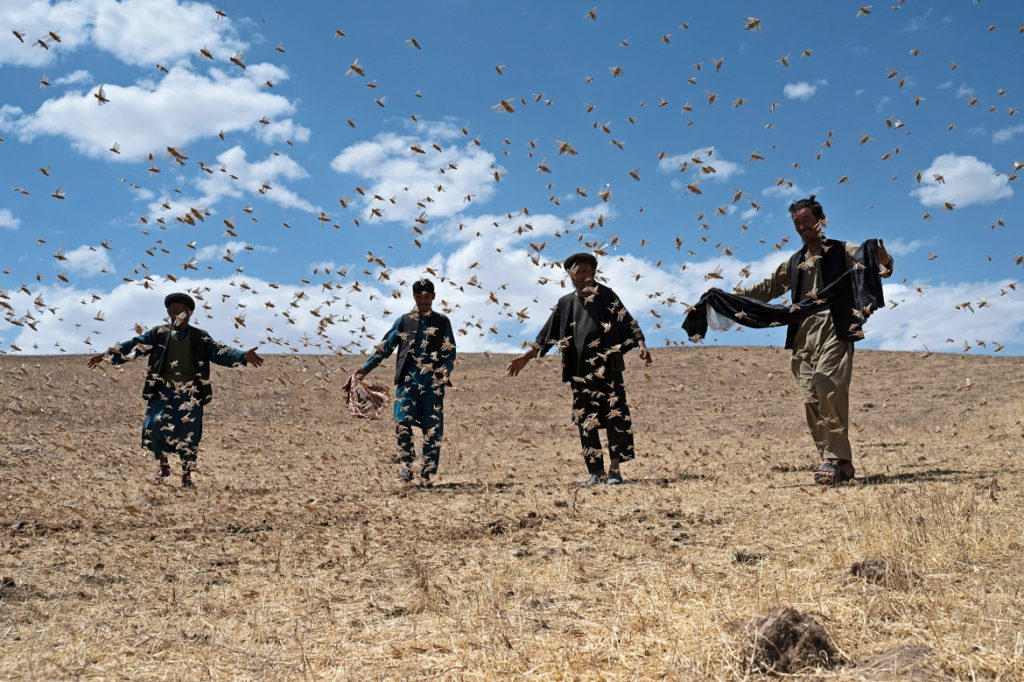By Mira Ries
In March 2023, for the first time in two decades, swarms of Moroccan locusts (Dociostaurus maroccanus) arrived in northern Afghanistan. Drought, excessive grazing, minimal early control efforts, and rainfall all contributed to create the perfect environment for locusts to hatch and form swarms. On May 10 the UN Food and Agriculture Organization (FAO) issued an advisory note warning of a major outbreak in the country’s wheat basket.
The Moroccan locust is considered among the most economically damaging plant pests in the world. It feeds on over 150 types of plants, encompassing tree crops, pastures, and 50 essential food crops that are cultivated in Afghanistan. The species represents an enormous threat to farmers, communities and the entire country,” said Richard Trenchard, the FAO Representative in Afghanistan—especially since 15 million people in Afghanistan already face acute food insecurity, according to the UN World Food Programme.
According to the FAO, thousands of individuals, along with NGO partners, and local authorities tirelessly fought to minimize the damage. Farmers and land-managers relied heavily on traditional ‘mechanical control’ methods, like digging trenches and burying immature “hoppers” to reduce the impact of the outbreak. Trenchard of the FAO said this was in part because chemical supplies were low across the country and the alarm calls came late. Frustratingly, a surplus of difficult to mobilize and perishable chemical pesticides have accumulated in East African countries, after the last desert locust outbreak of 2019–2021.
Although the FAO projected that a full outbreak could result in crop losses up to 1.2 million metric tonnes of wheat—up to a quarter of the country's total annual harvest and as high as USD 480 million in economic loss—the most severe scenarios have been largely averted. However, the situation is far from over, as considerable damage has resulted in food shortages in certain regions and billions of eggs lay waiting for the right conditions to return next year. This could create a major food crisis come May 2024 when the new generation of Moroccan locusts will begin to hatch.
According to the Telegraph, there is currently a $2.2bn shortage in funding for the agricultural sector, and earlier this year the World Food Programme was forced to slash rations for millions due to funding shortfalls.
Urgent solutions are needed to mitigate the looming locust timebomb, complicated by limited funds and political insecurity.
ASU’s Global Locust Initiative engages key actors in locust research and management to develop partnerships and solutions for transboundary pest management in agroecosystems around the world. If you have questions or are interested in engaging on this issue please join our online community of professionals on, HopperLink.
Video: FAO / AFGHANISTAN LOCUST OUTBREAK
More photos by Wakil Kohsar/AFP
FAO (May 2023) FAO warns of potentially devastating Moroccan Locust outbreak in Afghanistan’s wheat basket. UN Food and Agriculture Organization (FAO). Kabul. https://www.fao.org/asiapacific/news/detail-events/en/c/1639056/
The Telegraph (2023, June 30). Locust timebomb looms in Afghanistan after insects lay billions of eggs in cropland. Telegraph.co.uk. Retrieved July 10, 2023, from https://www.telegraph.co.uk/global-health/climate-and-people/locust-insect-plague-afghanistan-wheat-crops-famine/
